The popularity of the monarch butterfly has made milkweed a “must-have” for almost any butterfly or pollinator garden. That’s because milkweeds are the “baby food” for monarch caterpillars and we wouldn’t have monarch butterflies without milkweeds for their caterpillars to eat.
However, milkweeds also provide food for hummingbirds and a wide variety of other butterflies, bees, moths, and insects. That can make them an important component of any thriving backyard ecosystem, even if monarchs aren’t the primary animals you want to attract.
The three species of milkweed most commonly recommended for butterfly or pollinator gardens are common milkweed (Asclepias syriaca), swamp milkweed (Asclepias incarnata, also known as rose milkweed), and butterfly milkweed (Asclepias tuberosa, also known as butterflyweed). However, they aren’t your only options, and more importantly, they may not be the best options for your garden.
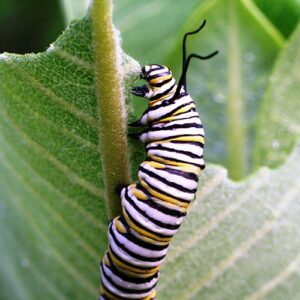
What most people don’t know is that there are almost 30 different species of milkweed native to at least some part of the eastern U.S. And those are just the ones that are native to this region. There are many more species that are native to other parts of the country or the world.
Of those 30 species that are native to part of the eastern U.S., somewhere between 1/3 and 1/2 of the species have very restricted ranges and are found in less than a handful of states. (The coastal states of the Deep South have the greatest number of those species with very restricted ranges.) Ten of the remaining species can be found throughout most of the eastern U.S. while the rest can be found in “more than a handful of states,” but not quite “most of the eastern U.S.”
It would be completely overwhelming, and not very helpful, if I tried to talk about all 30 species of milkweed that are native to at least part of the eastern U.S. in this article. The fact that a good number of those 30 species wouldn’t be native species for the majority of people reading this article would only make it more overwhelming and frustrating.
So instead, we’re going to focus on those 10 species that are native to most of the eastern U.S. and therefore will be applicable to the greatest number of people. But, there are a few things we need to talk about before we dive into a discussion of those species.
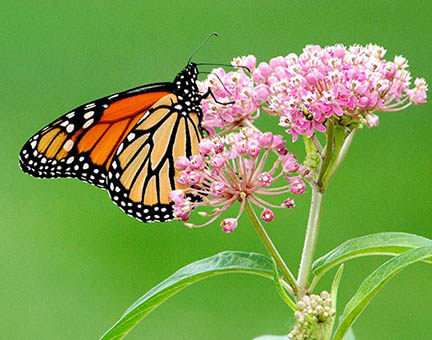
The Importance of Planting Native Species of Milkweed
It’s important to remember that even though we’re talking about species that are native to most of the eastern U.S., that doesn’t mean that they are all native to where you live. Before planting any milkweed, I recommend doing a little research to make sure it is native to your location because milkweeds that are planted outside of their native range may become problematic.
An example of this is common milkweed in Georgia where botanists currently believe that it was probably introduced to the state. Other species, which aren’t native to any part of the eastern U.S. and have been introduced from much further away can become even more problematic. A good example of this is tropical milkweed (Asclepias curassavica) which has become popular in the traditional horticultural trade.

Obtaining Plants or Seeds
Also, if we’re talking about planting these in our home gardens, then I think we need to take a moment to discuss how to obtain them.
First, as a gentle reminder, if you find these plants growing by the side of the road, on public land, or anything like that, please don’t dig them up. That’s called plant poaching and is highly frowned upon in the native plant world. On public lands there are often laws and regulations in place which can result in fines and even jail time for those convicted of plant poaching.
One of the reasons why removing plants from the wild is frowned upon is because there have been cases of native plant populations being completely wiped out by people digging them up. Sometimes the population loss was due to one person digging up too many plants, other times it was due to multiple people each taking a few plants. Either way, the end result was the species no longer being found in that location, which means that it is no longer available for all the species which rely on it, and the ripple effects spread out from there.
Another reason why digging plants is frowned upon is because digging up any of our deep rooted native plants, including mature milkweeds, will often kill them. So, if moving the plant is likely to kill it then, what are you really hoping to accomplish?
Seed collecting is considered much more acceptable than digging the plants up. However, different states and types of public land have different regulations for seed collection. Depending on where you are at, there may still be restrictions and regulations that you need to be aware of and follow. If you do decide to collect seeds from the wild, please make sure you only collect small quantities, use sustainable practices, have the appropriate landowner permissions, and follow any applicable regulations.
In a few cases, collecting seeds may be the easiest way of obtaining a particular species of milkweed for your home garden, just because that species isn’t often available for sale. However, most of the species we’re going to discuss are available for purchase through reputable native plant suppliers. Reputable native plant suppliers are propagating the plants themselves and aren’t going out and digging the plants from the wild or collecting commercial quantities of seeds from the wild.
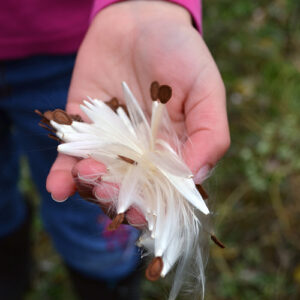
Always purchasing from reputable native plant suppliers is important. While you can sometimes find listings for native plants or their seeds on sites like Etsy, e-bay, Facebook Marketplace, Craigslist, and others, you have no real idea of who you are buying from, where those plants / seeds came from, or if they may be carrying diseases or pests that you really don’t want to introduce to your property. Your state’s native plant society is often a good resource for finding reputable native plant suppliers near you.
We also recommend that you try to purchase seeds or plants with genetics that are “as close to you as possible.” That is often harder to do, so just do your best and try to at least stay in your ecoregion. The reason you want local to local-ish genetics is because those genetics are going to be best adapted to the conditions in your region and will cause the plant to bloom at the right time for any specialist insects that use it in your area.
Overview of Milkweed Species
So, let’s take a look at the 10 species of milkweed that are found throughout most of the eastern U.S., including the pros and cons of using each species in your home garden. Since we’re talking about growing them in our home gardens, we’ll start with the species that are most easily found for sale and then move to the ones that are harder to find.
Common milkweed (Asclepias syriaca)
Common milkweed is one of our tall milkweeds and typically tops out around 5 feet tall but can get even taller. In the wild, it’s often found in prairies, meadows, old fields, and other open areas. It prefers really sunny areas and will fade out if an area becomes more shady.
It has pink flowers that form ball-like clusters which tend to droop down a little. The flowers have an absolutely amazing smell. Not only does common milkweed spread by seeds, but it also spreads by rhizomes or runners. In fact, it spreads so quickly by rhizomes that even in the wild it often forms colonies.
This is one of the three species that is often recommended for pollinator and butterfly gardens, but I always hesitate to do so. It’s easy to find seeds or plants for it and it’s great for larger pollinator plantings where it has lots of space to spread. However, for smaller settings like home gardens, it can quickly become too aggressive as it sends out those rhizomes or runners.
Not long after we moved here, I created a new garden bed that was relatively large and planted 3 to 5 common milkweeds in it. I knew common milkweed was supposed to be aggressive but thought that I could easily control just a few plants. Within a few years it completely took over that bed, crowded out practically everything else, and began moving out of the bed. I’ve seen the same thing happen to lots of other people too. In my opinion, there are usually better options for garden settings.
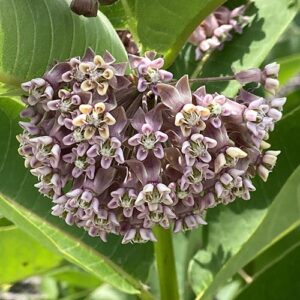
Swamp milkweed or Rose milkweed (Asclepias incarnata)
Swamp milkweed is another tall milkweed that can grow up to approximately 5 feet tall. In the wild, it is usually found in wetter open areas like wet meadows or prairies, riparian areas, swamps, and marshes. It prefers sunny areas, but can take a lot more shade than common milkweed.
The flowers are generally light pink to kind of a magenta color. The flower clusters tend to point more upwards than common milkweed clusters. Like common milkweed, it can spread by seeds and by runners or rhizomes, but it doesn’t send out nearly as many rhizomes as common milkweed.
Swamp milkweed is another of the three most commonly recommended milkweeds for pollinator or butterfly gardens. In my opinion, if you’re looking for a tall pink milkweed for a garden setting, then swamp milkweed is usually a better choice than common milkweed, because it doesn’t spread as aggressively by runners.
Now, if you’re thinking, “But my garden isn’t a swamp…,” then don’t worry. It doesn’t have to be excessively wet. In cultivated situations where you can water it occasionally during droughts, swamp milkweed does perfectly fine with medium moisture soils. It just doesn’t like super dry soils.
Because it is so commonly recommended, it is really easy to find swamp milkweed seeds and plants. Many of your native plant nurseries will have it and even some of your big box stores and traditional nurseries may carry swamp milkweed. There are also multiple cultivars of the species which offer a variety of flower colors. However, remember that changing traits like flower color can affect what insect species are attracted to that plant.
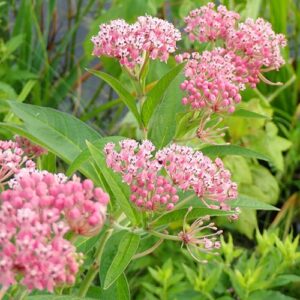
Butterfly milkweed or Butterflyweed (Asclepias tuberosa)
Butterfly milkweed is a shorter milkweed that usually tops out around 3 feet tall. Mature plants can take on something of a bushy appearance. In the wild it is found in dry open areas like prairies, pastures, and roadsides. It loves those sunny dry conditions.
The flowers are orange and form in upward pointing, flat-topped clusters. It spreads primary method by seeds. It doesn’t spread by runners or rhizomes like some of our other milkweed species do, which can be a big plus in garden settings.
Butterfly milkweed is another one of the three most commonly recommended milkweed species for pollinator or butterfly gardens. It is also the one I often recommend to people who joke that they have a brown thumb, instead of a green thumb. It is very drought tolerant once it is established, so can handle being forgotten about. In fact, I often tell people that you can “love it to death” by giving it too much water or too rich of soil.
Like swamp milkweed, it is really easy to find plants or seeds for it. Once again, many of your native plant nurseries will have it and you may even find it in some of your big box stores and traditional nurseries. Also, like swamp milkweed, there are multiple cultivars available. However, research has shown differences between the types of bees that use at least some of the butterfly milkweed cultivars and those that use the straight species. So, as always, I recommend having a really good reason before choosing to plant one of the cultivars because you don’t know what kind of unintended consequences your choice may have.
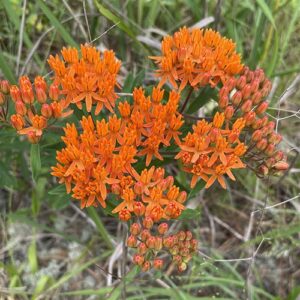
Redring milkweed or White milkweed (Asclepias variegata)
Redring milkweed is another shorter milkweed, which typically doesn’t get more than 4 feet tall. In the wild it can be found in open woods, savannas, and similar locations. It can sometimes take full sun, but definitely prefers to have some shade.
The flowers are bright white with reddish or purplish centers. They form tight clusters that make the flower cluster look like a snowball. It spreads entirely by seed and doesn’t produce rhizomes or runners.
Although absolutely stunning, redring milkweed is a little harder to find for sale than the “big 3” of common, swamp, and butterfly milkweed. It can be found for sale, both as seeds and plants, you just might have to look a little harder to find it. It can also be a little pickier about where it likes to grow.
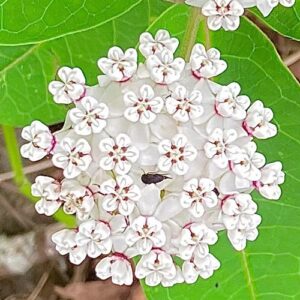
Whorled milkweed (Asclepias verticillata)
Whorled milkweed is a shorter milkweed that usually doesn’t grow more than 3 feet tall. In the wild, it can be found in dry open areas, especially those with thin, rocky soils. It is sometimes considered a pioneer species which may get crowded out of an area as taller plants become established.
The flowers are white to greenish-white and form in loose clusters. It can spread by seeds and by runners or rhizomes. Some people say that it can become aggressive if it really likes an area, but I don’t have enough personal experience growing this species to say one way or the other on it.
Like with redring milkweed, whorled milkweed can be a little harder to find for sale. There are reputable native plant nurseries that sell it, but they aren’t as common as for the “big 3” milkweed species.
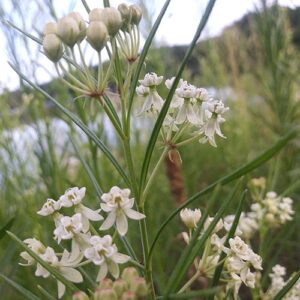
Poke milkweed or Tall milkweed (Asclepias exaltata)
Poke milkweed is another taller milkweed that usually tops out around 6 feet tall, but can get even taller if it really likes a location! In the wild, it is found in open woodlands, along the edges of woods, and in other somewhat shady locations. It tends to prefer soils that are somewhat richer and moister than average.
The main part of the flowers are whitish, while the back part tends to be green. The flowers form very loose, drooping clusters on relatively long stalks. It primarily spreads by seeds.
This is another species that is a little harder to find for sale, but it is doable with a little effort.an 3 feet tall. In the wild, it can be found in dry open areas, especially those with thin, rocky soils. It is sometimes considered a pioneer species which may get crowded out of an area as taller plants become established.
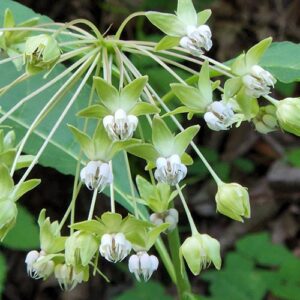
Green comet milkweed or Glade milkweed (Asclepias viridiflora)
Green comet milkweed is a short milkweed that doesn’t get more than about 2 feet tall. In the wild, it is most often found growing as scattered individuals in open areas such as glades, meadows, prairies, savannas, and old fields. It prefers sunnier and drier conditions with poorer soils.
The flowers aren’t very showy. They start out greenish and then turn purplish but never appear to “open up” like other milkweeds that are native to this region. The flowers form loose clusters that droop down.
It can be pretty hard to find green comet milkweed for sale, perhaps because it doesn’t have very showy flowers and requires very specific site conditions. However, it is an option if you have its preferred conditions and can find it.
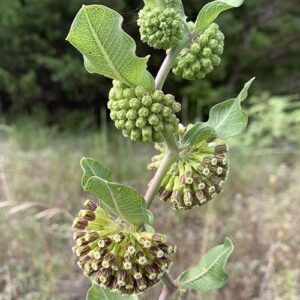
Clasping milkweed or Sand milkweed (Asclepias amplexicaulis)
Clasping milkweed is a short milkweed that doesn’t get much taller than 2 feet. It’s not very common in many areas because it has pretty specific growing preferences. It likes dry, sunny, open areas, preferably with sandy or rocky soils.
The flowers are pink to purple and form in very loose clusters. It spreads by seeds. I almost never see it for sale, but if you have the right site conditions then you might want to try to locate some.
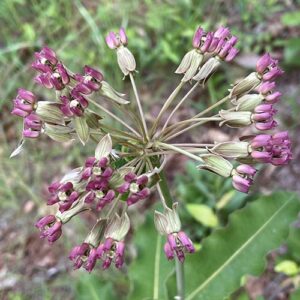
Fourleaf milkweed (Asclepias quadrifolia)
Fourleaf milkweed is another short species of milkweed. It typically maxes out around 3 feet tall. In the wild, it is most often found in open woodlands and along the edges of woods. It really likes to have some shade and tends to prefer drier, often rocky soils.
The flowers are a pale pink and grow in loose clusters. It spreads by both seed and rhizomes although it doesn’t spread very fast by runners or rhizomes.
This is another one that I almost never see for sale. However, if you have the right site conditions then it could be a beautiful addition if you can find it.
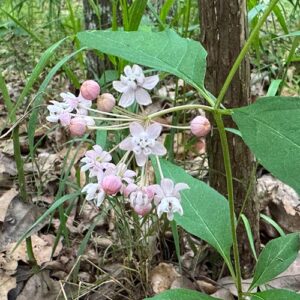
Longleaf milkweed (Asclepias longifolia)
Longleaf milkweed is another short milkweed that only grows to about 2 feet tall. In the wild, it is found in swamps and wet pine savannas. It is VERY site specific and won’t grow in areas that don’t have its required site conditions.
The flowers are white and purple. They form in loose clusters that tend to point up or to the side and splay out slightly.
As far as I can tell, there are no commercial sources for it. But, that’s not a big deal for the purposes of this article because very few home gardens are going to have the site conditions this species needs. However, I thought it was still worth mentioning this species since it does have such a large native range.
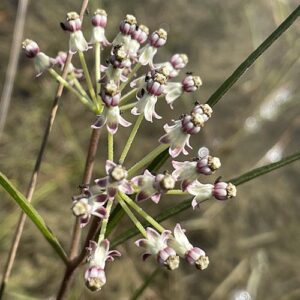
Summary
Growing milkweeds that are native to your location can be a great way to not only attract egg laying monarchs to your garden, but also many other pollinators. Luckily, there are lots of different types of milkweeds that have the potential to work really well in home gardens. So, no matter what type of soils you have or how sunny your location is, there’s likely a native milkweed species that is adapted to your conditions.
You also don’t have to limit yourself to just one species of milkweed. Some research suggests that different species of milkweed may be more attractive to egg laying monarchs during different parts of the season. So, if your goal is to attract more egg laying monarchs, then having a variety of milkweed species available may make your garden more attractive. Which can be a great justification when you can’t seem to pick just one species to grow in your garden…😄
If you would like personalized help creating your own pollinator and wildlife habitat, then we encourage you to check out the Backyard Ecology™ Community.
There’s lots of great “big picture” information available about creating pollinator gardens or larger habitats for pollinators and wildlife. What’s lacking are opportunities to say, “This is what I want to do. This is what I’m struggling with. How do I make it work on my property?”
That’s part of what the Backyard Ecology™ Community offers its members every day.
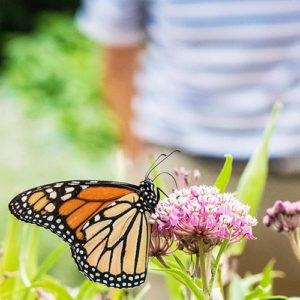
Thank you!
These amazing individuals go above and beyond every month to provide financial support which helps us create so much free content for everyone to enjoy and learn from.
Julie Krygier, Lizabeth, Russel Furnari, Crystal Robinson, Karen Veleta, Kevin B, Sally Mirick, Crystal Dyamonds, Mitchell Bell, Laura Hunt, Sue Ann Barnes, Adrienne Richardson, J. Adam Perkey, Ariel, Cara Flinn, David Todd, LaVonne Fitts, Cathy, Michael, Tom Winner, Eric Fleming, Julie, SB H, Christopher Scully, Craig, Rachel Antonucci, Melissa Egbertson, Switzy, CotswoldsCottageMA, Vilma Fabre, Pia O Nomata, Linda McNees, HerculesBiggerCousin, Patrick Dwyer, Paul Gourley, Lilith Jones, John Master, William Morin, Lori Sadie Ann, Debra, Ayn Zitzman, Han Mad, Isaac Kowis, Cathy Anderson, Betsy Lessels, Reid, and Dave Teare.
Backyard Ecology™: Creating thriving backyard ecosystems that you can enjoy and be proud of
We created Backyard Ecology™ to help you confidently create pollinator and wildlife habitat that you can enjoy and be proud of. Because nature isn’t just “out there.” It’s all around us, including right outside our doors.
Our focus on the eastern U.S. means that the information we share is applicable to you and where you live. Join us as we ignite our curiosity and natural wonder, explore our yards and communities, and improve our local pollinator and wildlife habitat.
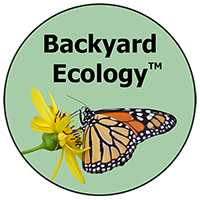
Backyard Ecology™’s Guiding Principles:
🦋 Curiosity: Nature is fun, interesting, and worth exploring. We will never know everything. Answers lead to more questions. That’s half the fun.
🦋 Balanced: You don’t have to choose. You can support nature AND have a beautiful property that you can enjoy and be proud of.
🦋 Science informed: Habitat creation and management should be based on the latest scientific research available. This is true regardless of whether you’re working in a small garden or on hundreds of acres.
🦋 Stewardship: Anyone can make a positive difference in the natural world and leave an ecological legacy on their property.

Leave a Reply